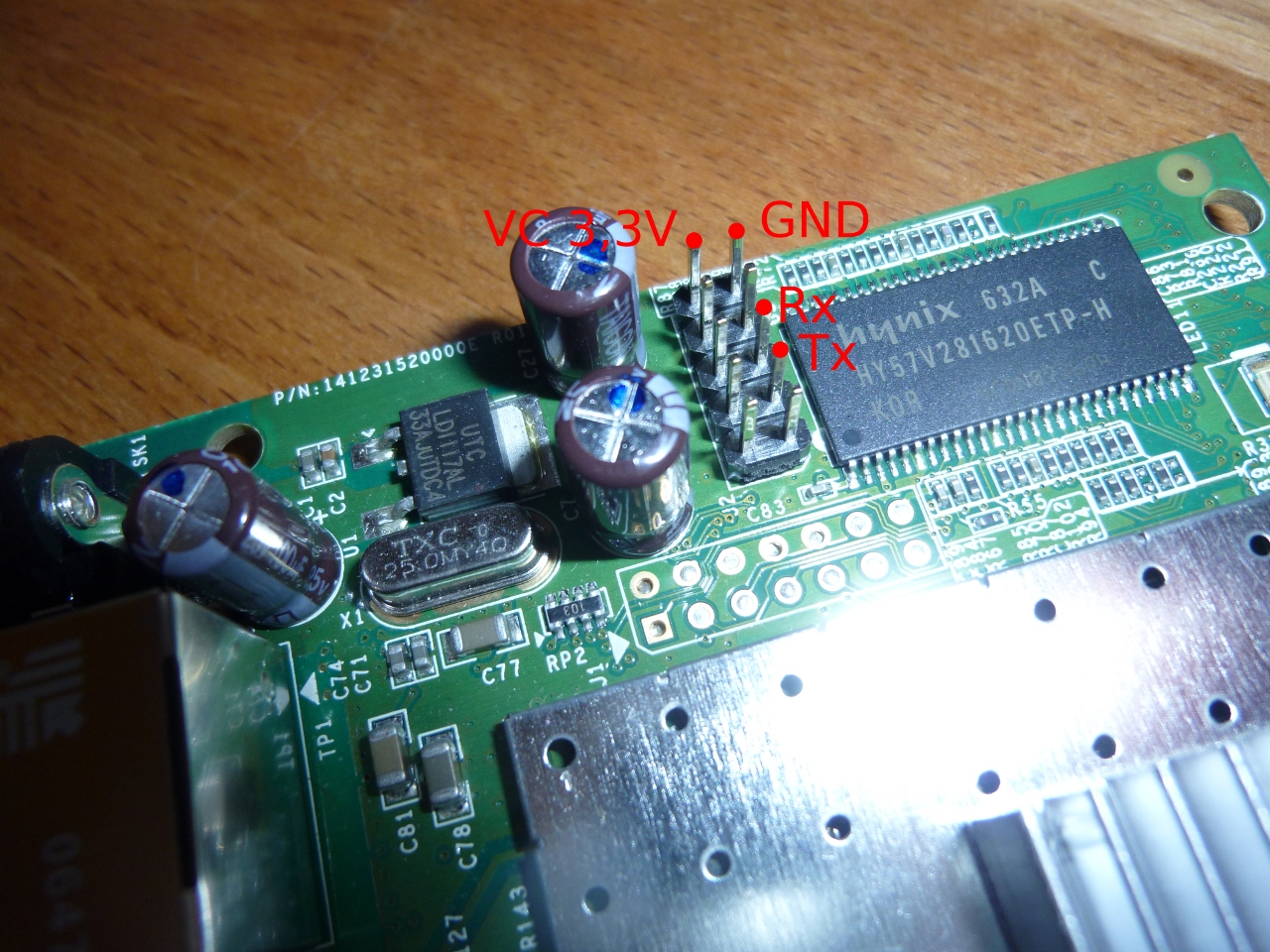(Stichworte: Fonera_-_Superhelle_LED, Fonera_-_SD_Karte, Fonera_-_LED)
Flashen
Fonera 2100
Via Redboot
Telnet nach Redboot
Redboot hört(falls aktiviert) beim Start unter 192.168.0.1 und Port 23 auf eine Telnet Verbindung. Hier kann man sich einloggen und mit [strg]+[c] den Bootvorgang abbrechen. Los gehts...
santa-cruz tftproot # ls -l
insgesamt 2432
-rw-r--r-- 1 nitro users 1703936 3. Apr 15:14 openwrt-atheros-2.6-root.jffs2-64k
-rwxrwxrwx 1 nitro users 786432 30. Sep 2007 openwrt-atheros-2.6-vmlinux.lzma
lrwxrwxrwx 1 root root 34 3. Apr 15:32 root -> openwrt-atheros-2.6-root.jffs2-64k
lrwxrwxrwx 1 root root 32 3. Apr 15:34 vmlinux -> openwrt-atheros-2.6-vmlinux.lzma
RedBoot> ip_addr -h server_ip -l fon_ip/netzmaske
RedBoot> fis init
RedBoot> load -r -v -b %{FREEMEMLO} rootfs
RedBoot> fis create -l 0x006f0000 rootfs
RedBoot> load -r -v -b %{FREEMEMLO} vmlinux
RedBoot> fis create -r 0x80041000 -e 0x80041000 vmlinux.bin.l7
RedBoot> fis load -l vmlinux.bin.l7
RedBoot> exechat mal nicht funktioniert Yves 15:41, 23. Apr. 2009 (UTC) Zusätzliches zu Redboot Methode
* statt TFTP geht auch HTTP mit -m HTTP -h DIE.HTTP.SERVER.IP
* Die Freifunk Hannover Leute rechnen sich 0x80041000 mit bc wie folgt aus [2] : fis free zeigt den verbleibenden freien Speicher:
RedBoot> fis free
0xA80F0000 .. 0xA87E0000
:~# bc
obase=16
ibase=16
A87E0000 - A80F0000
6F0000
RedBoot> lo -r -b %{FREEMEMLO} openwrt-atheros-2.6-root.squashfs
RedBoot> fi cr -l 0xCHANGE rootfsVia SSH/Linux-Konsole
Beispiel selbstgebautes Image
user:~# scp openwrt-atheros-2.6-vmlinux.lzma root@<fonera_ip>:
user:~# scp openwrt-atheros-2.6-root.jffs2-64k root@<fonera_ip>:
'oder'
root@OpenWRT:~# wget http://downloads.openwrt.org/kamikaze/7.09/atheros-2.6/openwrt-atheros-2.6-vmlinux.lzma
root@OpenWRT:~# wget http://downloads.openwrt.org/kamikaze/7.09/atheros-2.6/openwrt-atheros-2.6-root.jffs2-64k
root@OpenWRT:~# mtd -e vmlinux.bin.l7 write openwrt-atheros-2.6-vmlinux.lzma vmlinux.bin.l7
root@OpenWRT:~# mtd -e rootfs write openwrt-atheros-2.6-root.jffs2-64k rootfs
root@OpenWRT:~# rebootYves' lastflash
fis init
load -r -v -b %{FREEMEMLO} -m HTTP /~yvesf/rootfs
fis create -l 0x006f0000 rootfs
load -r -v -b %{FREEMEMLO} -m HTTP /~yvesf/vmlinux
fis create -r 0x80041000 -e 0x80041000 vmlinux.bin.l7Marc's lastflash example
working for 2100
RedBoot> fconfig
fis load -l vmlinux.bin.l7
exec
RedBoot> reset
RedBoot> load -r -b %{FREEMEMLO} -m HTTP /~marc/openwrt/vmlinux
RedBoot> fis init
RedBoot> fis create -e 0x80041000 -r 0x80041000 vmlinux.bin.l7
RedBoot> load -r -b %{FREEMEMLO} -m HTTP /~marc/openwrt/rootfs
RedBoot> fis create rootfs <- funktioniert!
RedBoot> resetum sich per ssh einloggen zu können:
root@Openwrt:/# passwd
root@Openwrt:/# uci set network.lan.ipaddr=<ip>
root@Openwrt:/# uci commit network
root@Openwrt:/# rebootFonera 2200
+Ethernet eth0: MAC address 00:18:84:80:bf:d8
IP: 192.168.1.254/255.255.255.0, Gateway: 0.0.0.0
Default server: 0.0.0.0
RedBoot(tm) bootstrap and debug environment [ROMRAM]
Non-certified release, version V1.00 - built 10:37:27, Dec 12 2006
Copyright (C) 2000, 2001, 2002, 2003, 2004 Red Hat, Inc.
Board: FON1
RAM: 0x80000000-0x81000000, [0x80040aa0-0x80fe1000] available
FLASH: 0xa8000000 - 0xa87f0000, 128 blocks of 0x00010000 bytes each.
== Executing boot script in 10.000 seconds - enter ^C to abort
RedBoot>
RedBoot> ip_addr -l 192.168.1.254 -h 192.168.1.2 ...
RedBoot> fis init (evtl -f)
RedBoot> load -r -b %{FREEMEMLO} kernel.lzma
RedBoot> fis create -e 0x80041000 -r 0x80041000 vmlinux.bin.l7
RedBoot> fis free
RedBoot> load -r -b %{FREEMEMLO} rootfs.squashfs
RedBoot> fis create -l *0x730000* rootfs
RedBoot> reset\*0x* fis free -> 2. - 1. => -l *0xDAS*
Power over Ethernet Cable (PoEC)
Folgend eine kleine Anleitung, wie man den Fonera über das Ethernet Kabel mit Strom versorgt. Da ein 100 MBit Ethernet nur 4 von den 8 Adern eines Netzwerkkabels verwendet, können wir die restlichen 4 für unsere Zwecke missbrauchen. Wir werden die Aderpaare 4,5 und 7,8 verwenden.
###
1 # #
###
###
2 # #
###
###
3 # #
###
Diode: 1N4001
###
4 # ####### ## #
### # # # # ###
#################### ################## # Vcc
### # # # # ###
5 # ####### ## #
###
###
6 # #
###
###
7 # #######
### # ###
########################################## # GND
### # ###
8 # #######
###Warum nicht unten an der Platine die Stromkabel anschliessen? Die betreffenden Pins sind nicht aus dem RJ-45 Gehäuse ausgeführt.
RS232 Pinout
** ACHTUNG: Die Fonera bootet NICHT wenn ein Pegelwandler beim einstecken an der seriellen Schnittstelle angeschlossen ist!**
From above (2100):
RIGHT
----------------------------------
VC +3,3 -> # # <- GND |
# # | FRONT
# # <- RX |
# # <- TX |
# # |
 |
| Fonera 2100 Pinout | Fonera 2200 Pinout |
GPIO
funktioniert mit den (2100) openwrt binarys:
root@f09:~# gpioctl dirout 2 #wlan LED
root@f09:~# gpioctl set 2
root@f09:~# gpioctl clear 2Die anderen GPIOs werden hier beschrieben: http://wiki.openwrt.org/toh/fon/fonera#gpio